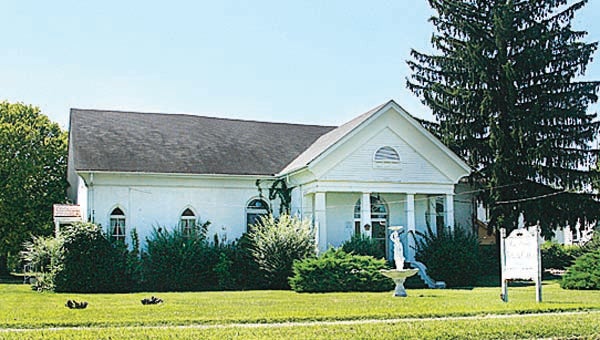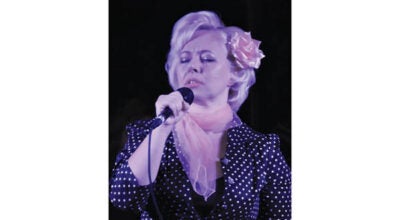Exploring the stories of Carter County’s historic places of worship
Published 9:44 am Monday, September 14, 2015

Star Photo/Abby Morris-Frye
The old Elizabethton Presbyterian Church, now the Magic Moments Wedding CHapel, has served almost every congregation in Elizabethton at one time or another. The building has a colorful history as during the Civil War the Carter Brothers, W.B. and Alfred Moore, were members of the church. They were also Union activists. There are also stores about Parson Brownlow delivering a fiery speech or two at political rallies held at the church.
There’s a story to be gleaned from almost any subject, be it a person, building or object. Among the most interesting places to explore are churches, especially the older churches in Carter County communities.
Churches used to be, and still are in many communities, the cornerstone. Oftentimes, they are the oldest institutions in a community, and they instill a particular attraction. They are at the center of life’s great transitions. Baptism, confirmation, marriage and death are all cradled in their arms. Their walls are witness to life’s greatest joys and deepest pains, and their wisdom is immense.
Churches usually not only have a multitude of stories to tell, but they have sentimental value. It can be about the architecture, associated people, even the objects inside the churches.
Most churches are monuments to faith — faith in God, faith in its people, faith that, no matter the odds, it will prevail and continue to grow.
History of St. Thomas Episcopal Church
One of the oldest churches in town is St. Thomas Episcopal Church, on Second Street behind the Carter County Courthouse. Long before it was an Episcopal church, it was the worship place for the Southern Methodist Church. The church was built from bricks made on site.
When those early parishioners were building the church, little did they know that their service would mark the beginning of a church that would stand the test of time, survive a war and internal strife, and carry on their humble fellowship years later.
However, the congregation’s history goes much further back to when it was the Methodist Episcopal Church and members met in the courthouse and later in the Duffield Academy and in a building where First Free Will Baptist Church now stands. The church had a circuit-riding preacher, and often sermons at Sunday services lasted 21⁄2 hours. Can you not imagine the yawning and dozing that went on in those services and the use of cardboard fans by parishioners on warm Sunday afternoons?
Among those first parishioners were John Singletary, Mrs. John Wilcox and family, the Rhudys, Dungans, Hunters, Tiptons and Jobes, Will Shell’s family, and the Folsoms.
A church divided
The Civil War split the Elizabethton Methodist congregation. The Northern branch of the congregation later built a new church on F Street, now known as Harvest Baptist Church. In the beginning it was known as Singletary Methodist Church, named for John Singletary. Among early church members were Mr. and Mrs. Nat T. Perry, Mr. and Mrs. C.P. Cass, Mr. and Mrs. O.H. Viall and Mr. and Mrs. John F. Ryan.
Through the years, the building has housed different congregations and had different names, including Grace Baptist Church, Bible Baptist, Revival Church, Lighthouse for Jesus, and now Harvest Baptist.
Also listed among the oldest congregations in town is the old Presbyterian church on Main Street, now a wedding chapel. If the walls of that building could talk, what stories they could tell — of Aunt Jennie Johnson teaching Bible stories to the children; of the devoted service of Dr. James E. Cameron and his father, Jacob; of the heated conversations about the Civil War that no doubt took place inside, and of the work of the Carters, especially W.B. and Alfred Moore Carter, both of whom were Union activists; not to mention the fiery speeches given by circuit riding preacher Parson Brownlow at political rallies insie the church. Brownlow went on to become governor of Tennessee.
Just as worship was the main purpose of the church’s weekly meetings, early churches were firm believers in discipline for its members. Early records indicate both men and women were disciplined for such acts as “crimes of fornication” and traffic and use of intoxicating drink. Such acts could lead to suspension or expulsion from the church.
Minutes from one session of the Elizabethton Presbyterian Church minutes dealt with the appointment of a committee to visit Landon Carter and converse with him on his “religious deportment and to cite him to appear and answer to the session at its next meeting.”
Another session dealt with a man and wife being cited on charges of “intemperance and using profane language, and behavior unbecoming a Christian character.” The two refused to meet with the session and both were excommunicated. I wonder how well this would go over in today’s congregations.
Murder at Roan Mountain Church Revival
Perhaps the most violent and cowardly act in a local church building occurred at the old Bowling Chapel Methodist Church in the Crabtree community of Roan Mountain. The church building, which still stands by the side of the road, is marked by time and age. The paint on the exterior has peeled, the tin roof is now rusty, and the bell tower is absent its bell.
In October 1933, a 32-year-old Carter County constable in the Roan Mountain community was shot in the back as he led singing at a revival meeting inside the church.
According to an account from the Elizabethton Star, John Arnett, was shot in the back by his third cousin, Howard Arnett, who stood outside the church and shot through a window. The shooting occurred on a Tuesday evening, and Arnett died the following Friday morning.
The article stated that witnesses on the outside of the church told authorities that as the shooter raised the gun to fire through the window, he is alleged to have said, “I have killed rabbits and squirrels with this gun, but this is the largest game I have ever brought down.”
“The constable was shot immediately after prayer had ended and he had just started to reach for a song book to lead the singing,” the article read.
Accomplices in the shooting were identified as Dayton Arnett and Robert Julian. All three were later tried and sent to prison for a period of time.
The shooting apparently was the result of the constable seeking to bring some law and order to the community after an outbreak of vandalism and the breaking and entering of homes and a store in the community.
When the church closed its doors several years later, many of its parishioners joined Roan Mountain United Methodist Church. The small Bowling Chapel Church had been a part of the community since 1807.
Despite the shooting, its members had sweet memories of the church. Mrs. Joe Whitehead, now deceased, recalled being a part of the church in her youth and the powerful preaching by some of its pastors, the fervent prayers and songs of praise, dinners on the ground, and Vacation Bible School. “I remember most of the people who attended the church. They were good people, who loved the Lord, and most would have given you the shirt off their back,” she said.
No doubt those early parishioners had memories of Tweetsie, the small narrow gauge train. The railroad track was next to the church, and at least twice a day, the little train chugged and whistled its way past the church as it made its daily run to Cranberry, N.C., and back.
The small abandoned church was also the subject of one of Don Iverson’s paintings.
All of our older churches still resonate with history of days gone by.
There is a part of me that believes some walls really can talk and do have a story to tell. Their language is a blending of history, imagination and belief, a belief that the people and events that came before us matter. They do, of course, matter. We only need to listen.





